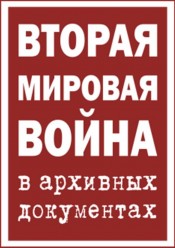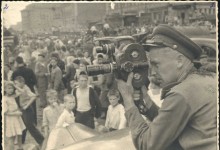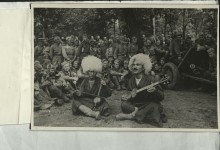
Documents on portal of Presidential Library tell about development of art during the Great Patriotic War
On May 3, 2024, the Collection "World War II in Archival documents" on the Presidential Library's portal was replenished with more than 40 photographic documents and manuscripts from the collections of the Russian State Archive of Literature and Art (RGALI) and the State Archive of the Russian Federation (GARF) of the key period of the Great Patriotic War (from November 19, 1942 to November 7, 1944).
The Collection includes documents reflecting the cultural life of the country during this period, authors versions of wartime songs that gained national love, author's manuscripts of the most significant works of literature, cinematographic materials reflecting the heroic struggle of the Soviet people against the Nazi invaders, photographs of performances by concert brigades that went to the frontline to perform in front of the soldiers of the Red Army.
Alexander Tvardovsky's poem "Vasily Terkin" can be called without exaggeration one of the key works created during the Great Patriotic War. The image of a strong, good-natured and devoted Red Army soldier Vasya Terkin was bear by Tvardovsky back in the years of the Soviet-Finnish war, but he gained incredible popularity with the reader during the Great Patriotic War. The first chapters of the poem began to appear in frontline print in 1942, and work on it continued until 1945. The original of the 17th chapter of Vasily Terkin has been preserved in the holdings of Russian State Archive of Literature and Art, which is currently included in the State Register of Unique Documents of the Archival Holdings of the Russian Federation.
Few people know that Vasily Terkin had a real prototype – the poet-front-line soldier Vasily Glotov. Handing him the first edition of the Book about the Fighter, published in Smolensk, on Tvardovsky's native land, the poet wrote on the title page: "To Vasily Glotov, a close relative of Vasily Terkin, my dear comrade in the war. A. Tvardovsky. 1945. Galingen Castle. Prussia." Illustrations for the poem were created by many artists at different times, but for most readers, the most recognizable drawings were made by the wonderful artist Orest Vereisky.
The unprecedented feat of the underground Komsomol organization "Young Guards", which operated from September 1942 to January 1943 in the city of Krasnodon in the Donbas was praised in the novel of the same name by Alexander Fadeev. The beginning of the writer's work on this topic was the article "Immortality", published in the newspaper Pravda shortly after the liberation of Krasnodon from German occupation and the discovery of the disfigured bodies of young underground workers in one of the mines. Subsequently, Fadeev carefully collected material for his future novel, met with eyewitnesses, studied documents that reflected the history of the "Young Guards". The manuscript of this work, as well as the documents collected by the writer, are kept in his personal holding in Russian State Archive of Literature and Art.
Despite the enormous losses and difficulties that the Great Patriotic War brought, this period became a time of new prosperity and productive work for the Soviet cinematography. Being well aware of the ideological power of film, the country's leadership did everything possible for cinema to inspire the Soviet people to victory, create the best heroic and lyrical images, call for struggle and revenge, and inspire hope for an early meeting with loved ones.
In November 1941, the Mosfilm and Lenfilm studios were evacuated to Alma-Ata, where the Central United Feature Film Studio (TsOKS) was formed. Eventually it accounted for about 80% of all films shot during the war. The Alma-Ata Palace of Culture, where Central United Feature Film Studio settled, became home to the most important Soviet directors and cameramen for three years. The work was carried out in the most difficult domestic and industrial conditions: filming took place mainly at night, when part of the electricity was released, which went to military factories during the day; The film set was not heated, there was not enough tape, and it was almost impossible to find building materials for the scenery.
And yet, the work at the studio went on nonstop. In a short time, such diverse films as "The District Secretary" (1942, directed by I. Pyriev), "Actress" (1942, directed by L. Trauberg), "Wait for Me" (1943, directed by A. Stolper and B. Ivanov), "She Defends the Motherland" (1943, directed by F. Ermler) and dozens of other full-length and short films, as well as the epic "Ivan the Terrible" by Sergei Eisenstein, were shown to the public.
One of the films created in 1943 at the Central United Feature Film Studio was "Taxi to Heaven" (directed by G. Rappaport, screenwriter E. Petrov). As many film critics note, the war not only influenced the aesthetics and problems of feature films, but also "legalized" much of what was pushed off the screens in the 1930s, when Soviet cinema was focused mainly on reflecting the labor enthusiasm of the people – the builder of socialism. With the beginning of the war, "suffering, pain, separations, losses, tears, hunger, fear" returned to cinematography, there was a "turn to humanity" that would reach its peak in the cinematography of 1950- 1960.
"Taxi to Heaven", which was criticized for the fact that "its characters do not strive for any high goal" became a striking example of this new formation. However, the audience loved the film, not least because of the magnificent acting duo of Mikhail Zharov and Lyudmila Tselikovskaya. After the release of the film, the artists repeatedly went to the front as part of concert brigades, where they were invariably greeted by the warmest welcome of soldiers and officers (especially military pilots who recognized themselves in the characters of the film).
Songs of the war years occupy a special place in the history of the Great Patriotic War. Calling to battle, marching, lyrical, soul-grabbing, they have long been part of the cultural code of our country, they have lived and continue to live with us in sorrow and in joy. It was these songs that, at the request of listeners, were regularly played on the air of one of the oldest Soviet radio programs, "Meeting with the Song". The host of the program, Viktor Tatarsky, received thousands of letters in which people talked about what they had to do with the frontline song: "The older boys from our group went to the front. How many of them died. Dear boys. They didn't live to see it, they didn't have time to love, saving the world from fascism. This song is about them, "Nightingales, nightingales, do not disturb the soldiers"...", – A. Zvyagintseva from Novosibirsk wrote bitterly in 2015.
V. Buberman echoed in her letter about her brother, a front-line soldier: "And wherever Vasily Petrovich was, no matter what he did, his favorite song "Dark in the Night" constantly lived in him. At that time, he did not have a native home, nor a beloved one leaning over his son's bed, this was waiting for him after the Victory, but the song lay so firmly on his heart that it became a part of himself." Autographs of the wonderful songs "Nightingales" and "A Handful of earth" by A. Fatyanov, "Dark in the Night" by V. Agatov, "Smuglyanka" by Ya. Shvedova, "Song of the defenders of Stalingrad" by E. Dolmatovsky from the collections of Russian State Archive of Literature and Art are presented in the Collection World War II in archival documents.
Front-line concert brigades provided great moral support to the soldiers and commanders of the Red Army during the war. Their performances gave the fighters moments of rest, allowed them to return to peaceful life at least for a short time, enjoy works of Russian classical music and literature, see a fragment of a performance by the metropolitan theater or laugh at the caustic anti-Hitler satire. Frontline concert brigades were formed in almost all cultural institutions throughout the Soviet Union. From June 1941 to May 1945, the front-line brigades gave, according to various estimates, from 1 million 350 thousand to one and a half million performances and concerts with the participation of about 42 thousand artists from almost four thousand brigades.
The holding of the Central Committee of the Professional Union of Art Workers (CC Rabis) in the State Archive of the Russian Federation has preserved numerous photographs of performances by concert brigades of artists of the Turkmen and Kazakh SSR, Mari and Adjara ASSR, as well as other Soviet republics and autonomies, leading collectives of Moscow and Leningrad, frontline theaters in the Black Sea Fleet, Bryansk, Northwestern, Volkhov and others on the fronts, in the territories of the USSR liberated from occupation. Similar documents are kept both in the holdings of cultural institutions and in the personal holdings of artists, readers and musicians in Russian State Archive of Literature and Art. Now they are available to a wide audience in the Collection "World War II in archival documents" on the portal of the Presidential Library.
In accordance with the List of instructions for the implementation of the Address of the President of the Russian Federation to the Federal Assembly of the Russian Federation dated January 15, 2020, the organizers of the Collection of Digitized Archival Documents, Film and Photo Materials "World War II in Archival Documents" are the Federal Archival Agency (Rosarkhiv), the Administrative Directorate of the President of the Russian Federation and the Presidential Library.
The Collection is carried out by Rosarkhiv and federal state archives with the participation of the Ministry of Defence of the Russian Federation, the Ministry of Internal Affairs of the Russian Federation, the Ministry of Foreign Affairs of the Russian Federation, the Federal Security Service of the Russian Federation, the Foreign Intelligence Service of the Russian Federation, the state archives of Belarus and others.
To date, the volume of the Collection is over 12 thousand materials: maps, diagrams, periodicals, photographs, newsreels for the period from January 1933 to December 1944.
Archival documents of the Collection World War II in Archival Documents are available from anywhere in the world thanks to the Presidential Library’s portal. Especially for the foreign audience, the titles and annotations to the documents as well as the texts of the accompanying articles are also available in English.
In addition to digitized archival documents the Collection contains a list of the main Internet projects, databases, other thematic online documents, virtual tours of the history of World War II, developed by government agencies of the constituent entities of the Russian Federation and various organizations.












